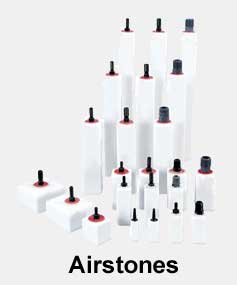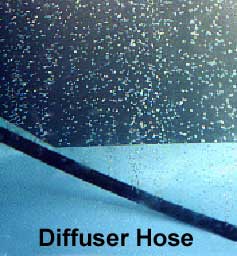Photos Courtesy of Aquatic Ecosystems, Inc.



The third pillar that successful recirculation systems depend on is gas exchange (the others are, of course, solids removal and nitrification). As discussed earlier, fish and bacteria consume oxygen and produce carbon dioxide in molar equivalents as they respire. The recirculation system, therefore, must add oxygen and remove carbon dioxide. Everyone who has seen an aquarium is familiar with the bubbling airstone and aeration using the atmosphere as a source of O2 is the basic method of gas exchange in most recirculating units.
 |
 |
 |
Air diffusers, such as airstones, are the most popular but there are other ways of encouraging the diffusion of oxygen from the air into the water including allowing the water to spread over a thin layer, as in a trickle filter, or spraying the water into the air, by means of a spinning paddle type aerator (as seen in bait shops). No matter how it is done, diffusion depends on the available surface area, the thickness of the stagnant boundary layer, and the partial pressure gradient of oxygen across the gas/water interface (See Ch. 3). Ultimately, the density of fish that can be raised in a recirculation unit of a given size is limited by gas exchange. Specifically, it is impossible to move enough oxygen into the water from the air to support more than about 0.5 lb/gal (60 g/L) of fish. Extremely intensive recirculation systems, therefore, depend on pure oxygen, which can support up to 0.75 lb/gal (90 g/L) or even higher. For our discussion, we will use the term aeration to refer to methods that derive oxygen from the atmosphere and oxygenation for the use of pure oxygen.
Diffuser-based aeration increases gas exchange by providing increased surface area of the gas/water interface at the bubble surface. It also stirs the water thinning the stagnant boundary layer at the bubbles and the top of the water. The first step in diffuser-based aeration is to move the air. Instead of the common piston driven air compressor found on construction sites, recirculation aquaculturists use high volume, low pressure blowers. These blowers use energy to move more air at lower pressure rather than less air at higher pressure. For example, a 2.5 hp blower typically moves air at about 120 ft3/min (3.4 m3/min) at 15 lbs/in2 (760 mmHg), while a compressor of the same power would move only 4 ft 3/min (0.1 m3/min) but at 90 PSI (4500 mmHg). Aquaculturists only need enough pressure to overcome pipe friction and hydrostatic pressure of the tank, but need great volumes. Next a diffuser must be selected. The most common is the stone type, a larger version of the aquarium airstone. These are made of a variety of materials including glass beads, fused silica (sand), and porous ceramic. Each type produces bubbles of a different size. In general, smaller bubbles are preferred because the same volume of air broken into smaller units increase the surface area for diffusion. On the other hand, fine pored diffusers are more expensive and require higher air pressure. Other types of diffusers include plastic types and porous rubber hose. Porous rubber hose is marketed for air diffusion, but it is essentially the same as the commonly available drip irrigation, "soaker" hose. This is the cheapest for very large applications.
The air must be moved from the blower to the diffuser through pipe. As in the plumbing for water, plastic PVC is cheap and easy to work with. Though air flows through pipe much more easily than water, there is friction involved that robs head and reduces flow. As with water, short runs, bigger pipes, and avoiding right angles reduces friction loss. Diffusers are usually placed in the fish tank where oxygen is most critical. More diffusers mean more gas exchange...up to point. There is a limit to how much gas exchange can be accomplished with aeration. It reaches the point that frothy water hinders the ability of fish to swim, eat and grow. An advantage of aeration over oxygenation is that if aeration is sufficient to move necessary oxygen into the system then the movement of carbon dioxide out of the system generally takes care of itself.